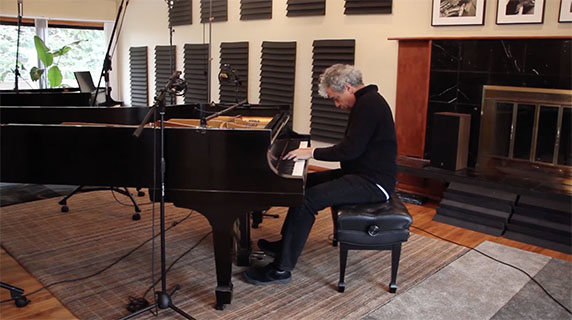
Jovino Santos Neto
Three-time Latin Grammy nominee Jovino Santos Neto, a master pianist, composer and arranger, is among the top Brazilian musicians working today.
Live Seminar Resources
Live Seminar Resources
PDF Downloads
- Alone Together with triads
Join PianoGroove Pro to access all downloads and learning resources.
Download theory supplements, midi files, chord changes and full note-for-note transcriptions of every lesson.
- Brigas Nunca Mais with triads
Join PianoGroove Pro to access all downloads and learning resources.
Download theory supplements, midi files, chord changes and full note-for-note transcriptions of every lesson.
Seminar Description
Seminar Description
Harmonic Creativity With Triads
Welcome to this in-depth lesson on harmonic creativity using triads. This session explores how triads can be used in a flexible and intuitive way to enhance your improvisation, comping, and melodic creativity. We examine two beautiful standards—one jazz standard, Alone Together, and one Brazilian standard, Brigas Nunca Mais—to apply these concepts in a musical context.
Triads are often thought of as rigid, basic chord structures, but this lesson highlights their elasticity and adaptability. By focusing on second-inversion triads and their adjacent notes, we can create rich harmonic textures and smooth voice leading.
The Elasticity of Triads
Many pianists associate triads with simple major or minor chords, but in jazz, triads can function in a much more dynamic way. Instead of thinking of them as static shapes, we approach them as fluid harmonic tools.
A second-inversion triad (such as C major in the order G–C–E) is particularly useful because it places the root in the middle, allowing for easy expansion with adjacent notes. This means that a single triad can imply multiple harmonic colors depending on the surrounding context.
For example, a D minor chord can incorporate:
- F major triad (F–A–C)
- C major triad (C–E–G)
- A minor triad (A–C–E)
By arpeggiating or layering these triads, we avoid thinking purely in scales and instead construct melodies through harmonic structures.
Harmonic Application in Alone Together
Alone Together features a minor 2-5-1 progression (D-7b5 to G7 to C-), providing an excellent opportunity to explore triadic superimposition. Instead of strictly playing scale-based lines, we use triads that relate to each chord in a way that enhances the melodic movement.
Minor 2-5-1 Breakdown:
- Over D-7b5, you can use F major, A minor, and C major triads to highlight guide tones.
- Over G7, options include B diminished, D major, and F major triads to bring out altered tensions.
- Over C-, using Eb major, G minor, and Bb major triads can create a rich minor sonority.
By focusing on these structures, we create melodies that feel harmonically grounded while remaining melodically engaging.
Applying Triads in Brigas Nunca Mais
This Jobim composition features beautiful harmonic movement that lends itself to triadic exploration. The opening Bbm6 can be approached using:
- F major (F–A–C)
- D minor (D–F–A)
- A minor (A–C–E)
Similarly, the A7 chord doesn’t have to be played with a stock voicing. Instead, we can use triads such as:
- C# diminished (C#–E–G)
- E major (E–G#–B)
- F# minor (F#–A–C#)
By stacking these triads over the chord changes, we create fluid and compelling harmonic motion while avoiding a linear scale-based approach.
Ruthless Left-Hand Voicings With Triads on Top
A key concept in this lesson is separating harmony into two functional layers:
- The left hand plays a rootless voicing.
- The right hand outlines melodic and harmonic extensions with triads.
For instance, over a D-7 chord:
- Left hand: F–C–E (rootless voicing)
- Right hand: F major triad (F–A–C) or A minor triad (A–C–E)
This approach works beautifully in both solo piano and ensemble settings. When playing with a bass player, we avoid redundant low-end voicings and instead focus on richer chord extensions.
Five Practice Tips
- Explore Second-Inversion Triads – Start with second-inversion triads and experiment with adjacent notes to expand your harmonic vocabulary.
- Think Harmonically, Not Just Linearly – Avoid running scales; instead, create lines using overlapping triads.
- Use Rootless Voicings in the Left Hand – Focus on guide tones (3rds and 7ths) in your left hand while playing triads in your right.
- Superimpose Triads Over Chords – Try playing different triads over each chord to find interesting colors and tensions.
- Train Your Ear to Hear Triadic Movement – Sing or play simple triadic shapes and listen for their harmonic pull within chord progressions.
This lesson encourages you to rethink triads as flexible, creative tools rather than simple chord structures. By integrating these ideas into your playing, you’ll develop a more intuitive and expressive approach to jazz harmony. Keep experimenting, and let your ears guide you!







